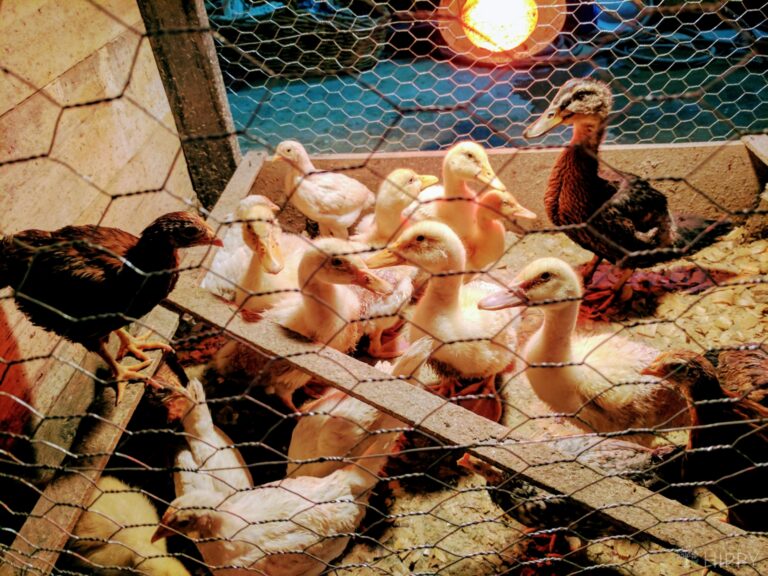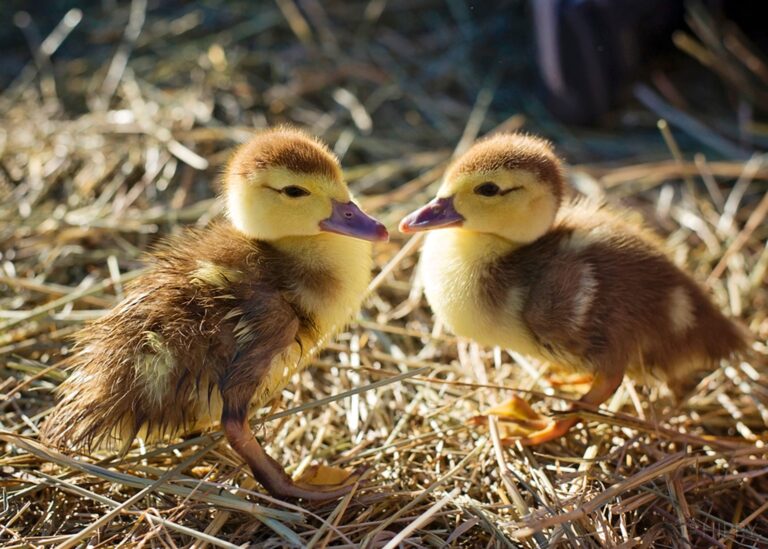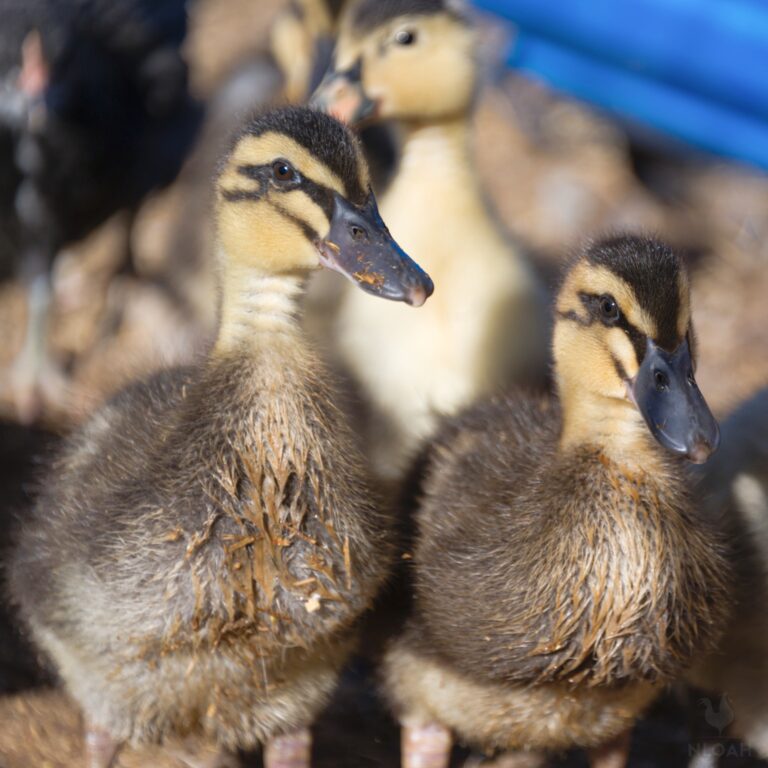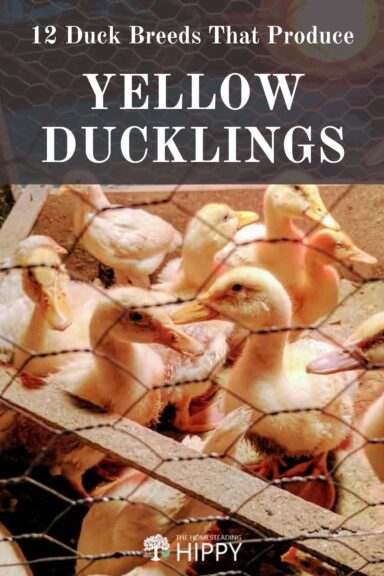There is hardly any image cuter and more innocent than a fluffy, fuzzy and perfectly yellow duckling. Whether it’s sitting serenely in the palm of your hand or a troop of them is diligently following their mother to water, they are so adorable it’s hard to stand it.

What you might not know is that not all ducks start out as these sweet, yellow babies. Some ducklings start out brown or various other dark shades.
But if you are in love with yellow ducklings and look forward to the day that you hatch your own, keep reading because I’ll tell you about 12 duck breeds that always start out yellow or mostly so.
Mallard
Arguably the most recognizeable duck breed on Earth, Mallards are an entirely common sight around lakes and rivers throughout the year.
One of the single most plentiful wild species found throughout North America, and one of the most common domesticated ducks, you should also know that most domestic breeds originate from Mallard stock.
Freshly hatched Mallard ducklings are mostly or partially yellow, typically along the flanks, neck, and much of the face but they also have a distinctive black streaking or eyeliner above each eye. The underside is almost always entirely yellow.
But Mallards don’t stay yellow, of course, and they will darken significantly once they enter their juvenile phase and begin to grow their adult feathers.
Call
If you want a tiny pet duck, you can hardly do better than the Call. Call Ducks were originally used as living decoys to lure in wild ducks for hunters to shoot.
Those days are pretty much over everywhere, thankfully, and today they’re kept as pets alone or else as exhibition animals for poultry shows and competitions.
I know, they are as cute as they can be being so tiny and white, but I warn you that these are the noisiest ducks that have ever lived, and they call and cackle at all hours of the day and night!
Calls tend to be pure white over the entirety of their body, and like other white breeds we’ve already looked at, this means that the ducklings are born pure yellow.

Muscovy
Muscovies are noteworthy for several reasons. For starters, they are taxonomically closer to geese than true ducks, but they’ve been domesticated for so long and identified as ducks no one seems keen to put them back in the right category.
These big, strong birds have many color variations, and accordingly, their ducklings come in many different colors.
Yet two of the most common are yellow, brown, or a mix of the two, and the ducklings can also have different colored beaks, ranging from darker colors like black and brown to gray, orange, or even a salmon color. Also note that Muscovy ducklings lack the red, fleshy caruncles that adults have.

Rouen
The Rouen is another dignified domestic duck that is raised for its superb, rich meat and also as a show bird owing to their large size, graceful build, and beautiful feathers.
They’re even kept for their eggs, and though satisfactory for a family or smaller operation they don’t really keep pace with the more productive breeds like Khaki Campbells.
Rouens are notable for looking very much like typical Mallards, only they are three to four times the size of a domestic or wild Mallard.
Naturally, their intricate patterns and colors make them highly attractive, but just like Mallard ducklings, they start out yellow with brown patches and brown eyeliner stripes.
In fact, that eyeliner is one of the few ways to tell the ducklings apart; Rouens have a second eyeliner stripe directly beneath the eye, not just across it as with Mallards.
Saxony
Saxonies are one of my very favorite domestic duck breeds, and I think it is a shame we don’t see them in backyard flocks more often!
Big, tall, stoic, and gorgeous, these impressive birds are often kept for meat production in Europe but are just as likely to be seen as ornamentals or show birds here in the United States. Despite their size, they are calm and very easy to handle.
Their brown and slate gray coloration is understated but dignified and pretty, but they don’t start out looking that way: Saxony ducklings are almost entirely yellow, though they’ll often have some brown speckles or spots here and there.
As they get older, the yellow disappears and they take on their adult colors. Notably, Saxony ducklings have a pale pink or salmon-colored beak and dark yellow-orange shanks and feet.
Magpie
Magpie ducks are a popular ornamental breed and also highly productive egg layers, and though their friendly demeanor and tendency to bond strongly with human owners make them a favorite pet duck. However, their high energy levels, curiosity, and adventurous nature means that they must have plenty of room to roam and exercise, including when on the water.
These demands for space can put folks with smaller properties to the test: they can get unhappy and noisy if they feel too confined.
Whereas the adult Magpie is instantly recognizable from its white and black patches, the babies will take a while to develop that stark coloration: they start out a pale lemon yellow and have brown patches on their head, flanks, and back. Once again, the bill and shanks are a light orange color.
Aylesbury
Aylesbury ducks are big, with a stout, thick stature and a long, curving neck. Raised for meat and also as an exhibition bird since the 18th century, sadly these iconic and impressive animals have suffered greatly in the 20th century and are critically endangered in the United States and the UK.
They are also easy to confuse with the far more numerous and productive Pekin found elsewhere on our list, as both ducks have blazing white feathers and bright orange feet and shanks.
And as expected for a domestic duck that is white all over, Aylesbury ducklings are a bright, even yellow all over, but notably, they’re born with a pink bill; it will turn orange as they mature into adults.
Northern Shoveler
Northern Shovelers are a truly remarkable duck, and also easy to recognize at a glance. That’s because of their wide, flat, thick and strong bill that they use to dig through sand, mud, and other substrates looking for food.
As strange as they sound, they are fairly popular as dependable and healthy egg layers, and also as pet ducks in backyard flocks because of their calm and friendly disposition.
The ducklings are born with varying degrees of yellow down depending on the color of the adult feathers. White is one such possible variation, and Northern Shovelers with white feathers will be born nearly entirely yellow. Darker freather colors like black or brown will show varying amounts of brown down in kind.
American Pekin
The Pekin, and specifically the American Pekin, is the iconic image of what a domestic duck looks like. Huge, fluffy, white, and having thick orange legs and an orange-yellow bill. They also happen to be the single most popular domestic duck breed in the US and are also popular around the world.
These broad-breasted ducks are raised predominantly for meat, but they are also popular as backyard utility ducks and are sometimes kept just for fun.
That may be more than most folks bargained for because these ducks really love splashing water around, and are notorious for making a muddy mess!
Like most pure white ducks, Pekin ducklings hatch an even, all-over yellow color, but they don’t stay yellow for nearly as long as you think:
Despite their large overall size, American Pekins have been selectively bred for generations for rapid growth, and as soon as those adult feathers start to come in, you’ll notice the yellow down of the ducklings fading away steadily.
German Pekin
German Pekins are very similar to American Pekins, but there are enough differences that they are considered their own breed.
Like the American duck, these are big birds, but even bigger: drakes max out at about 12 lbs! Also just like their American cousins across the pond, they have a pure, even white color accented by that iconic bright orange bill and legs.
The sheer size and heft of the German Pekin makes them prone to unwanted weight gain and also injury if they fall or have to jump down, but they tend to be a little healthier compared to the American variety.
And no surprise here: German Pekin ducklings are pure yellow all over.
Buff Orpington
A friendly, productive, and easy breeding duck, the Buff Orpington shares its color and its name with the breed of chickens. That’s because they hail from the same famous farms in the UK, Orpington Farms!
These ducks are known for friendliness and being easy to handle, but they’re also known for being highly broody! These Mamas are intent on hatching their eggs, and that can make getting a meaningful amount of eggs out of them difficult!
That beautiful light tan or fawn feathering that they have is another calling card of the breed, but they don’t start out that way: ducklings have mingled brown and yellow patches corresponding to where their adult feathers will be a little darker or a little lighter when they mature.
Indian Runner
Indian Runners are probably the most charming and instantly recognizable breed on our list. Standing truly upright, almost entirely vertical, they have a body plan that is very similar to the penguin.
Like the penguin, they are flightless and are forced to walk everywhere if they aren’t swimming. But more than walk, these birds really do run and have a surprising ground speed! Flocks of them are said to stampede when they get startled!
Despite looking a little funny, Indian Runners are also handsomely colored, with females having a speckled fawn, brown, and light gray color accented by a gray beak. Males have a chocolate brown head, white ring on the neck, and mingled brown, white, gray, and black feathers.
It’s hard to believe that their ducklings grow up to look like they do: they are simply an even yellow color all over with vivid yellow feet, shanks, and bills. And don’t worry, you won’t confuse your runner ducklings for another breed; you can spot the postural differences even at birth.

Tim is a farm boy with vast experience on homesteads, and with survival and prepping. He lives a self-reliant lifestyle along with his aging mother in a quiet and very conservative little town in Ohio. He teaches folks about security, prepping and self-sufficiency not just through his witty writing, but also in person.
Find out more about Tim and the rest of the crew here.
